.
Ever since I started my vegetable garden in 2020, I wanted to have a greenhouse. The vision of growing warmth-loving plants like peppers, cucumbers, eggplants, and tomatoes and prolonging the gardening season was very appealing. So, I searched for ready-made options I liked and could afford. Little did I know then, that I was ending up building a greenhouse from scratch, let alone showing you how to build a greenhouse by yourself.
Research
As I said, I first looked for ready-made options. There were, of course, several varieties of greenhouse kits but a greenhouse of the size I wanted (about 10 x 3 metres) was nearly impossible to find and when I finally found one, it was definitely not within my budget! Another problem was that all these greenhouse kits had to be fixed onto a solid concrete base. As I do not own my garden but have rented it I am neither allowed to plant deep-rooted bushes or trees nor set up anything permanent. Like a solid concrete base. But how to make sure that the greenhouse would be safely anchored without a base? There were, of course, greenhouse tunnels that had a frame made of curved PVC tubes that are stuck into the earth. However, as we have severe storms around here, especially during autumn, I was afraid that one of those would haul the greenhouse out of the ground and crash it into a nearby neighbour’s window. So, a greenhouse tunnel with a frame of PVC tubes was certainly not an option either It was my dad, finally, who suggested building a greenhouse from scratch with wood and using ground sleeves as point foundations. I was sceptical at first if sleeves would be enough to keep a greenhouse safely anchored but after one year I can tell you: it works perfectly!
How to build a greenhouse: Preparation
But how to build a greenhouse? I’m not all thumbs when it comes to handcrafting but I haven’t had much experience either. Well, the first step is:
Drawing a greenhouse plan
First, I drew a rough plan of the greenhouse and talked it over with my dad and an aquaintance who is an experienced carpenter. I had to adjust some things and refine the details but in the end, I was good to go. Here is my draft. Feel free to use and adapt it if you want to build a similar greenhouse. 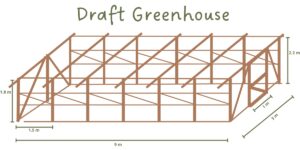 I set the greenhouse behind the vegetable garden, facing the south for optimal light yield. The south side is 1,8 metres high and 9 metres long, and the north side has a height of 2,2 metres. Those two long walls are 3 metres apart so I have gained 27 square metres of additional gardening space (9 x 3 metres).
I set the greenhouse behind the vegetable garden, facing the south for optimal light yield. The south side is 1,8 metres high and 9 metres long, and the north side has a height of 2,2 metres. Those two long walls are 3 metres apart so I have gained 27 square metres of additional gardening space (9 x 3 metres).
Measuring and setting up a string frame
First, I measured out the space behind the vegetable garden where I wanted to build my greenhouse and marked it with strings. I’m glad my dad helped me with that. If you (like me) have never done this before: don’t worry. Here’s a step-by-step guide on how to set up a string frame: When you have decided where to put your greenhouse, you hammer a wooden (or metal) stake into the ground to mark a corner of your future greenhouse. Make sure that at least 20 cm of the stake is above ground because that’s where we will attach the string. Next, you measure out the small side (in my case 3 metres) and hammer in a second stake. Connect these two stakes with a string. You then measure out the long side from one of the two stakes (here: 9 metres) and hammer in a third stake. Again, connect this stake with the first one. Now comes the coolest part: measure the diagonal length from the second to the third stake and make a note of the length. If, like in my case, you want to build a large greenhouse, you can do that with the help of a string that you attach to the second stake and pull it to the third one. Otherwise, you just use a folding rule. Mark the spot on the string where it touches the stake and measure it. Now you measure from the first stake to a (at that point imaginary) fourth stake until you have the same diagonal length as measured before between stakes two and three. Hammer in the stake and connect the last side with the string. 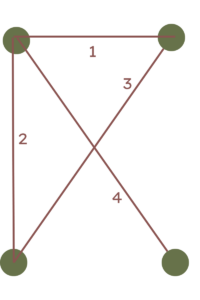
How to build a greenhouse: Setting up the frame
Setting the ground sleeves
With the string frame in place, I started to hammer in the ground sleeves, one on each corner and then one every 1,5 metres at the long sides. I used sleeves with a length of 90 cm and a 7×7 cm base on the top. At the front of my future greenhouse, i.e. the short side facing east, I additionally added two sleeves where the doorframe would be. All in all, I used 16 ground sleeves (7 on each long side and two for the door frame) It’s essential to make sure that all sleeves are at the same height. To ensure that I used a plank, put it across two sleeves and measured with a spirit level. As the area I built my greenhouse on is not plain, I had to decide what my reference point for height was. Naturally, I took the deepest point in my greenhouse area where I let the sleeve stand out 20 cm above ground. The other sleeves were adjusted accordingly. That meant that while the reference sleeves stood out 20 cm, some had to go 10 cm into the ground. There, I shovelled away the earth and hammered the sleeve into the right height. After every sleeve, check that it is level with the others.
Erecting the wooden beams
At my dad’s workshop, I sawed 8×8 wooden beams to the right length which I determined with good old Pythagoras. I added an extra 15 cm, though, as I wanted the beams to protrude over the south edge. This was necessary, as I intended to fix a gutter to this side. In the end, I had 7 beams with 1,8 metres (south side) and 7 with 2,2 metres (north side) all with an angle of 13 ° at the upper side. The two beams for the doorframe were adjusted later. To fit the wooden beams into the sleeves, I had to plane 0.5 cm on each side of the lower 10 cm of the beams. Remember: the sleeves I used measured 7×7 cm and the beams were 8×8 cm. I did the planing by eye and if the beams did not fit, I took off some more wood with a drawknife. After fitting the beams into the sleeves, I drilled holes into them through the pre-made holes in the sleeves and stuck 8 cm carriage bolts into them. Lastly, I screwed them tightly into the sleeves using the carriage bolts and nuts.
Constructing the greenhouse frame
Once the pillars were set, I started to build the wooden framework for which I used boards that were 2,5 cm thick, about 20 cm broad and 4 – 5 metres long. I fixed the first board with a screw clamp across the bottom of the front corner pillar, starting at the south side. 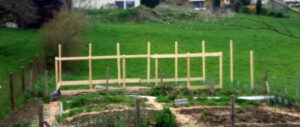 Then I marked where it hit the last pillar it could reach (in this case the third), took it off and sawed along the mark (by hand; there’s no electricity in my garden). After fixing it again with two screw clamps, I screwed the board to the pillars. In that way, I did all the bottom boards around the greenhouse and afterwards started screwing boards to the upper side of the pillars. I just had to remember that no bottom board was needed where the door should be built.
Then I marked where it hit the last pillar it could reach (in this case the third), took it off and sawed along the mark (by hand; there’s no electricity in my garden). After fixing it again with two screw clamps, I screwed the board to the pillars. In that way, I did all the bottom boards around the greenhouse and afterwards started screwing boards to the upper side of the pillars. I just had to remember that no bottom board was needed where the door should be built.
Adding windows
Next, I installed the frames for the windows that I wanted to build into the sections on the south and north sides. For this purpose, I took wooden battens (5 cm x 2,5 cm), measured the distance between two beams, sawed it to the measured length and screwed it in between the beams. For each window, I needed an upper and a bottom batten to complete the frame.
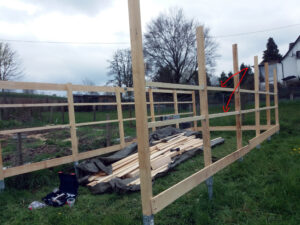
Window frames
Now the windows had to be built. This was the same as building the window frames but with additional sidebars. I measured out every section and sawed the battens according to measurement. Had I been an engineer or a carpenter, I think the pillar beams and thus the windows would have been of exactly the same size. As I’m not, however, the measurements varied a bit from section to section, so it made more sense to measure each section individually and saw the battens accordingly. When the windows were ready, I fixed them into the frames with hinges at the lower part, two on each window, making sure that they opened to the outside of the greenhouse. I can’t tell you the delight I felt when I opened my first (empty) window and it worked! In the end, I had 12 windows, six on the south and six on the north side and it was time to tackle the ceiling.
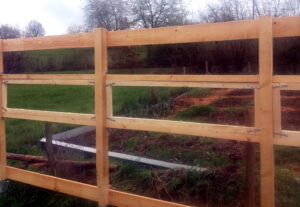
The windows are ready
Ceiling beams
Next, I laid beams of 3,15 m across the upright beams in a north-south direction so that they ended at the north side at the edge of the pillars and overhung on the south side by approximately 10 cm. I screwed the ceiling beams onto the pillars and additionally fastened them with metal angles. All, except the last one on the front. This beam I only laid loosely onto the pillars, inserted the remaining two beams into the sleeves where the doorframe would be and marked the height where I had to sew so they fitted in. I didn’t want to take the risk of calculating the height (I was never good at maths) so that seemed the best and easiest way to do it. 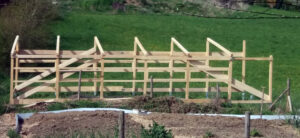 As the framework needed stability, I screwed boards diagonally across the backside, and the fields left and right from the door frame. I also installed diagonal boards from each pillar beam to the adjacent ceiling beam. That done, stability had improved A LOT!
As the framework needed stability, I screwed boards diagonally across the backside, and the fields left and right from the door frame. I also installed diagonal boards from each pillar beam to the adjacent ceiling beam. That done, stability had improved A LOT!
Reinforcing the ceiling
The wooden beams on top are adjusted in a north-south direction. To make sure the tarp wouldn’t hang loosely and build sacks when it was raining, I inserted boards between the beams’ sections. I started with the highest, i.e. the north side and screwed the boards on with angles so that they levelled with the top of the beams. I did three boards per section, one on the north side, one in the middle and one on the south side ending with the beams’ edges. 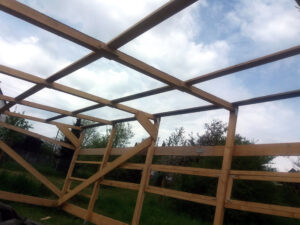
Building the door
Now, I had to build the door: I made a frame out of boards and stabilized it with a horizontal board in the middle and diagonal boards on the upper and lower sections. I then fixed it to the left pillar with hinges that were larger and thus more stable than the window hinges. It worked out wonderfully. 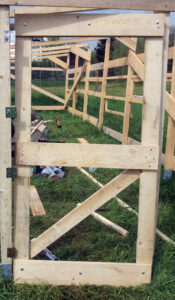
How to build a greenhouse: Covering
Research on greenhouse covering
The last step now was to cover the whole greenhouse frame with greenhouse film. I had done a lot of research in advance, comparing different possibilities like plastic twin-wall sheets, plexiglass, real glass and different greenhouse films. Twin-wall sheets and plexiglass were dismissed pretty soon as they would have been too expensive. The same went for true glass which had the additional disadvantage of heating the greenhouse too much so that a shading would have been necessary – which would have cost even more. So, film it was. Here, too, there are multiple possibilities. In the end, I opted for this heavy-duty tarp which, due to its grid is very stable and also thick enough to last several years (the manufacturer guarantees five years, but I think it may last a good deal longer. Time will show.)
Covering the greenhouse sides
Adjusting the heavy-duty tarp was the hardest part of this whole project as it lives up to its name and is very heavy. However, with the help of several clamps (and after a bit of swearing and sweating), the first edge was tightly screwed to the corner beam of the east side using plumber screws. Plumbing screws are metal screws with a rubber seal washer. That means that they have a larger contact area than without the washer, making sure that the film doesn’t tear out. Now, I pulled it to the next pillar and screwed it on, making sure that it was tightly stretched. Additionally, I fixed screws along the upper and lower board and around the window frames, clinging them firmly to the wood. I started at the back wall and worked my way around the entire house. I made sure that the film levelled up at the upper side of the greenhouse and overlapped at the lower side. 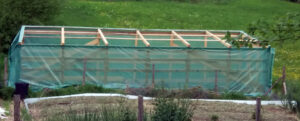 To enter the greenhouse, I used a sharp knife to cut a slit between the door and the doorframe. Next, I screwed a door latch onto the door and its counterpart onto the frame. Now I could It was a great moment entering “my house” for the first!
To enter the greenhouse, I used a sharp knife to cut a slit between the door and the doorframe. Next, I screwed a door latch onto the door and its counterpart onto the frame. Now I could It was a great moment entering “my house” for the first!
Covering the greenhouse ceiling
To get the ceiling covered, I first unfolded the tarp to its full size and then rolled it lengthwise. I then lifted it onto the ceiling and started to screw it onto the east beam. (Honestly, I don’t remember how I got that heavy foil onto the ceiling all by myself but I’m pretty sure that some cursing was involved.) 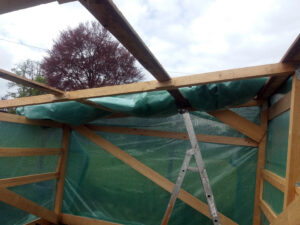 I then unrolled the film inch by inch, using a lot of plumbing screws to screw it onto the beams and boards. I took a screw every 10 – 15 cm, in short: a lot! But I was (and still am a bit) scared that the wind would rip off the film and tear the whole greenhouse apart and so I decided that in this case more is more.
I then unrolled the film inch by inch, using a lot of plumbing screws to screw it onto the beams and boards. I took a screw every 10 – 15 cm, in short: a lot! But I was (and still am a bit) scared that the wind would rip off the film and tear the whole greenhouse apart and so I decided that in this case more is more. 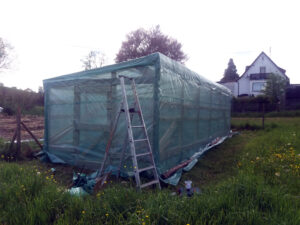
Opening up the windows and digging in the tarp
The whole house was covered now, and I opened the windows by cutting around between their edges and the frame with a knife, just like before when I opened the door. To keep the windows from falling open, I took some wooden scraps, “leftovers” from the bars I sawed earlier, and hammered them not too tightly onto the upper frame so that I could turn them and use them as a latch. 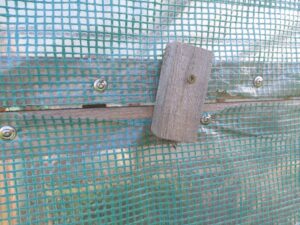 The last step on this building journey was to dig the overlapping tarp into the soil. I used a spade to dig slits into the earth, stretched the tarp and burrowed it tightly by firmly pressing the soil with my feet.
The last step on this building journey was to dig the overlapping tarp into the soil. I used a spade to dig slits into the earth, stretched the tarp and burrowed it tightly by firmly pressing the soil with my feet. 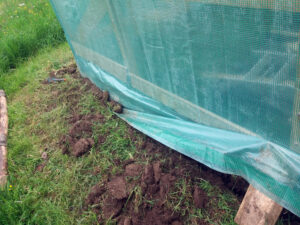
How to build a greenhouse: Final touches
Fixing the gutter
As a last step, I fixed a gutter to the south side of the greenhouse to collect the rainwater from the roof. I had bought several gutter brackets that I screwed onto the upper boards of the greenhouse frame, one bracket per metre. As you need a slight slope to one side to which the rainwater will be flowing, I fixed the brackets in a descending line from west to east. That means I started with the first bracket on the west side, screwed it almost at the top of the board and gradually lowered the brackets so that the last on the east side was about 10 cm lower. Then I stuck the gutter tubes together and inserted them into the brackets. I closed both gutter sides with end pieces. About one metre from the east side, I inserted a tube into the gutter that leads the water downward into a 1000-litre water container that I bought from eBay.
Prepare for planting
The greenhouse was now ready for preparation. For this, I used the same method as with my garden: I laid out cartons, put some leftover manure I still had from the last year and ordered some good humus. To calculate how much soil you need, calculate the pure planting space (i.e. without paths) and multiply it by 0,15 because you want your beds 15 cm high.
This is the soil for my greenhouse. It took me two hours to distribute it in the greenhouse.
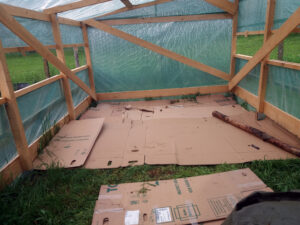
Laying out cardboard for bed preparation
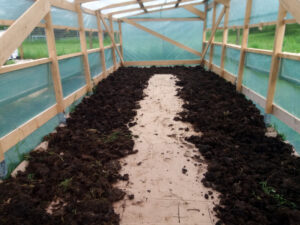
Distributing the manure evenly
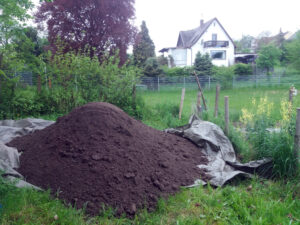
This is the soil for my greenhouse; it took me about two hours to get it all in and distributed
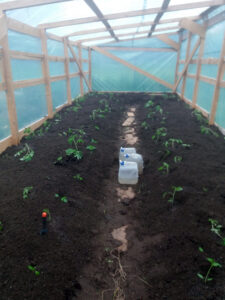
Ready for planting!
Finally, I was ready to plant my tomato, pepper and cucumber plants in the greenhouse which had grown very large already.
How to build a greenhouse: How much did it cost?
Now, what did the whole greenhouse cost? Sleeves (16): 100 € Wood (prepared and cut at the local sawmill): 500 € Screws: 200 € Hinges (24 for the windows, three larger ones for the door) + door bolt: 80 € Heavy duty tarp: 250 € Gutter: 100 € Water container: 80 € Total: 1305 €
Resume
Building your greenhouse is a rewarding and fulfilling project that allows you to enjoy year-round gardening. By following the step-by-step instructions in this guide, you’ll be able to construct a greenhouse that suits your needs and provides the perfect environment for your plants to thrive. Remember to maintain and care for your greenhouse to ensure its longevity and enjoy the abundance of fresh produce it can provide. Happy gardening!

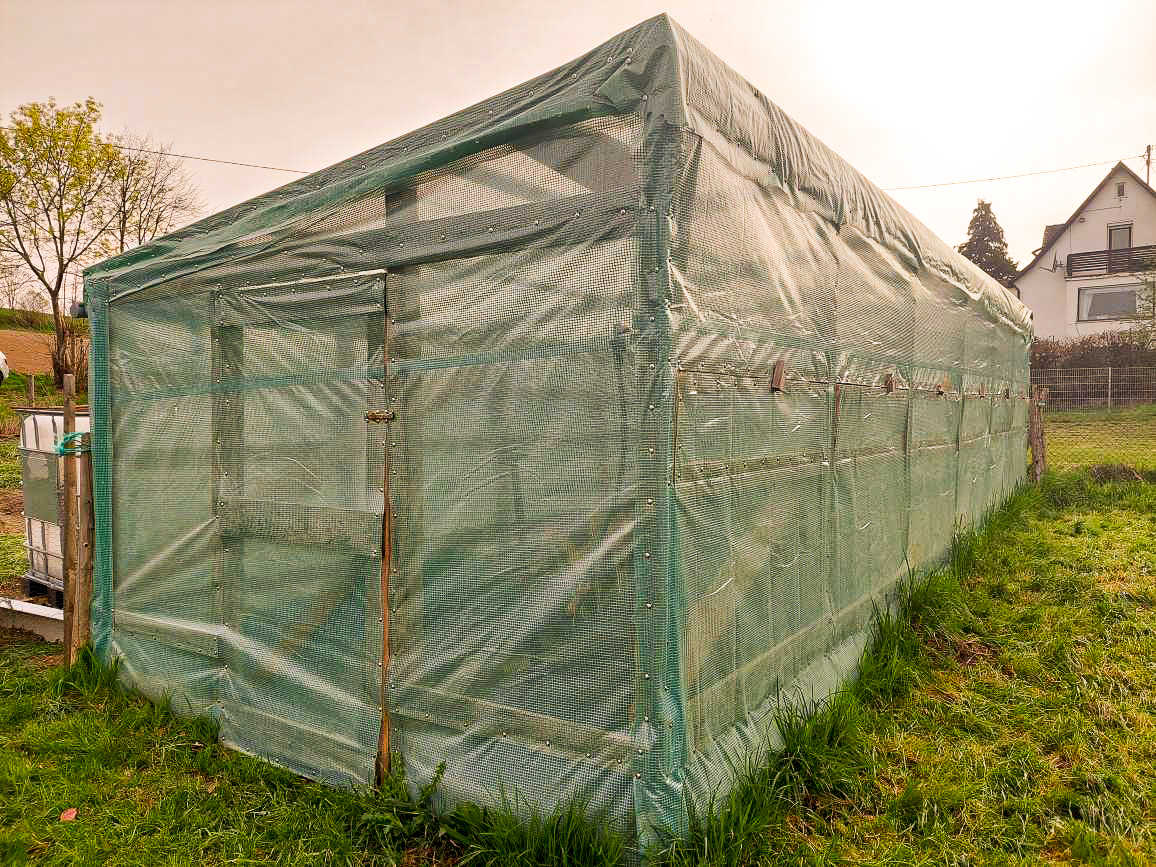
0 Comments